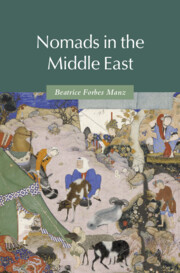Book contents
- Nomads in the Middle East
- Series page
- Nomads in the Middle East
- Copyright page
- Dedication
- Additional material
- Contents
- Figures and Maps
- Preface
- Maps
- Debate between Sheep and Grain
- 1 Introduction
- 2 Nomads in the Establishment of the Caliphate
- 3 The Rise of New Peoples and Dynasties
- 4 Turkic Tradition and Seljuqid Rule
- 5 Mongol Conquest and Rule
- 6 After the Mongols: Timurids, Turkmen and Ottomans
- 7 The Rise of Nomad Tribes,1500–1800
- 8 Nomads in the Modern Middle East
- 9 Conclusion
- Bibliography
- Index
6 - After the Mongols: Timurids, Turkmen and Ottomans
Published online by Cambridge University Press: 12 November 2021
- Nomads in the Middle East
- Series page
- Nomads in the Middle East
- Copyright page
- Dedication
- Additional material
- Contents
- Figures and Maps
- Preface
- Maps
- Debate between Sheep and Grain
- 1 Introduction
- 2 Nomads in the Establishment of the Caliphate
- 3 The Rise of New Peoples and Dynasties
- 4 Turkic Tradition and Seljuqid Rule
- 5 Mongol Conquest and Rule
- 6 After the Mongols: Timurids, Turkmen and Ottomans
- 7 The Rise of Nomad Tribes,1500–1800
- 8 Nomads in the Modern Middle East
- 9 Conclusion
- Bibliography
- Index
Summary
The fourteenth century produced three great conquerors: The Ottoman Yildirim Bayazid, Tokhtamysh of the Jochid Ulus, and Temür (Tamerlane) from Transoxiana. Tamerlane, aiming to dominate the former Mongol Empire and the Islamic world, defeated Bayazid and Tokhtamysh, but established administration only over the lands of the Ilkhanate and the western Chaghadayid lands. Separate identities developed among the descendants of the steppe nomads; nomad Anatolian powers traced descent from the mythical Oghuz Khan of the Turk Khaghanate, while Turco-Mongolians in the eastern regions remained faithful to the Chinggisid tradition according to which only descendants of Chinggis Khan could hold sovereign power. Temür suppressed tribal organization in his army and administration, but tribalism increased in borderlands, notably Anatolia. In the mid-fifteenth century, the tribal confederations of Anatolia – first the Qaraqoyunlu and then the Aqqoyunlu – took over western and central Iran. From this time on, tribes became central to the military and provincial organization of Iran. The courts of the period patronized literature and art in a mixture of Chinese, Central Asia and Islamic traditions, and Turkic became a language of high culture.
Keywords
- Type
- Chapter
- Information
- Nomads in the Middle East , pp. 139 - 167Publisher: Cambridge University PressPrint publication year: 2021



